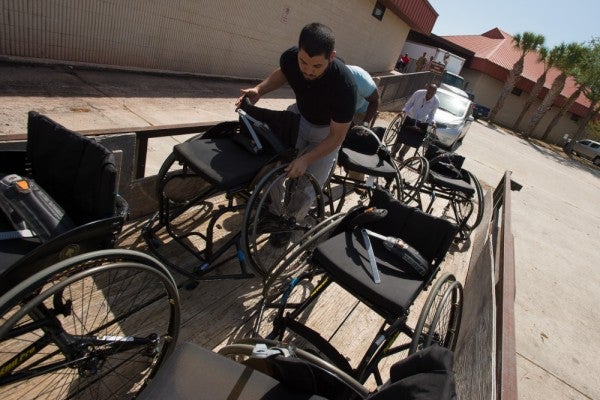Lawmakers turn up the heat on the VA to explain how it’ll reduce its 125,000 claim backlog
'We have not heard how you intend to ensure sanitation measures, supply PPE to veterans and providers, and manage the growing backlog.'

House lawmakers are turning up the heat on the Department of Veterans Affairs after it failed to provide them with a plan for safely cutting down on its increasing backlog of disability compensation & pension exams.
In a letter sent to VA Secretary Robert Wilkie on Tuesday, five Democratic lawmakers expressed their frustration with the department’s lack of transparency on the issue so far. The letter comes nearly three weeks after the department did not participate in a virtual forum about the issue hosted by Rep. Elaine Luria (D-Va.), chair of the Subcommittee on Disability Assistance and Memorial Affairs, on May 27.
“Over the past years VA has made great progress reducing the existing claims and appeal backlogs,” lawmakers wrote. “To ensure [Veterans Benefits Administration]’s hard work is not undone, VA needs a detailed plan that relies on input from VA staff, examination contractors, and veterans themselves. If you have a plan prepared, please work with the Office of Management and Budget to make your plan available to Congress as soon as possible.”
Related: 230,000 veterans’ disability ratings are stuck in limbo due to COVID-19
Veterans need C&P exams in order to receive a disability rating, but the department paused over 230,000 C&P exams on April 2nd to prevent further spread of COVID-19. While lawmakers said in the May 27 forum that they agreed with the decision to stop the exams, they also argued that the VA needed a back-up plan, such as conducting virtual C&P exams, so that veterans could still take the exams in order to receive disability ratings.
Experts from Veteran Service Organizations (VSOs) who were in the forum said VA was hamstrung in its efforts to conduct virtual exams by the fact that all but one of its virtual exams required in-home tele-practitioners, which doesn’t make sense in a pandemic when vulnerable patient populations ought to be social distancing.
“This is obviously the largest barrier we have identified in transitioning from in-person exams to a virtual model,” said Derek Fronabarger, government affairs director for the Wounded Warrior Project, at the forum.
What the VA did next did not ease many of the lawmakers’ concerns. The day after the forum, the department announced it would resume in-person exams at 20 facilities across the country. However, VA did not say how it would improve its virtual offerings, or explain how it would resume in-person exams in a relatively safe manner amidst COVID-19. House lawmakers restated their concerns in their letter on Tuesday.
Related: ‘Risk the coronavirus or keel over anyway’ — Veterans worry going to VA amid COVID-19
“In-person C&P exams have resumed in twenty cities across the country, yet we have not heard how you intend to ensure sanitation measures, supply protective equipment to veterans and providers, and manage the growing backlog,” wrote the lawmakers, who were Luria, Gilbert Cisneros Jr. (D-Calif.), Rep. Gregorio Sablan (D-Northern Mariana Islands), Colin Allred (D-Texas) and Lauren Underwood (D-Ohio).
As the COVID-19 pandemic continues, so too does the VA backlog of claims. According to the VA, claims pending for 125-plus days are considered “backlog.” In January, the VA had a backlog of 70,000 claims, but that number rose to over 125,000 as of last week, lawmakers wrote.
The representatives called for VA to provide a plan for reducing its backlog and figuring out its C&P exam process. Specifically, their questions include the following:
- What sanitation and social distancing measures are required during C&P examinations?
- How is this plan being communicated to providers, VSOs and veterans?
- What requirements can VA waive so that it can conduct virtual C&P exams without an in-home practitioner?
- How can VA use third-party contractors and VSOs to help with virtual exams?
- What is the status of benefit disability exams that VA provides to separating service members?
- How many vacancies for C&P examiners exist within VA and what is VA’s plan to fill them?
- What data has VBA collected on backlogged claims and how does it intend to address them?
- What risks are associated with the claims backlog and how does it intend to manage them?
